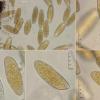
19-12-2025 10:10
Patrice TANCHAUDBonjour, récolte réalisée en milieu dunaire, a

18-12-2025 17:23
 Bruno Coué
Bruno Coué
Bonjour,je serais heureux d'avoir votre avis sur c

18-12-2025 21:17
Pol DebaenstThe identification took me to Byssonectria deformi

18-12-2025 18:07
Margot en Geert VullingsThese plumes were found on rotten wood.They strong

17-12-2025 18:35
 Michel Hairaud
Michel Hairaud
Bonjour à tous/Hi to everyone I am passing along

15-12-2025 15:48
 Danny Newman
Danny Newman
Melanospora cf. lagenaria on old, rotting, fallen

15-12-2025 15:54
 Johan Boonefaes
Johan Boonefaes
Unknown anamorph found on the ground in coastal sa

15-12-2025 21:11
 Hardware Tony
Hardware Tony
Small clavate hairs, negative croziers and IKI bb

15-12-2025 07:09
 Danny Newman
Danny Newman
indet. Rutstroemiaceae sp. on unk. fallen leavesMc
Could these conidia to belong to the anamorphic state, Hendersonia carpini Sacc., of Splanchnonema carpini?
They are inside conidiomata close to the pseudothecia of the last on Carpinus betulus branches
Thanks again

They may indeed be an anamorphic stage of the Splanchnonema, a fungus I do not know; but these are not the conidia of a Hendersonia in the traditional sense of a fungus with transverse true septa only - your fungus is distoseptate and muriform. It resembles species of Steganosporium (which are indeed anamorphic Splanchnonema).
best wishes
Chris
Thanks again
Hi Enrique,
yes, this should be Hendersonia carpini Sacc. (a younger homonym of Hendersonia carpini Otth which should represent something different). This species has recently been newly described in Persoonia as Camarographium carpini by Melnik et al. (see attachment). Published sequence data place it within Pleosporales.
Btw, Stegonsporium ("Steganosporium") is not an anamorphic Splanchnonema, but the anamorph of Prosthecium spp. on Acer (Diaporthales), see Voglmayr & Jaklitsch 2008: Prosthecium species with Stegonsporium anamorphs on Acer, Mycological Research 112: 885-905.
best wishes,
Hermann
Regards
Enrique


 Camarographium-carpini-FungalPlanet100-0001.pdf
Camarographium-carpini-FungalPlanet100-0001.pdf